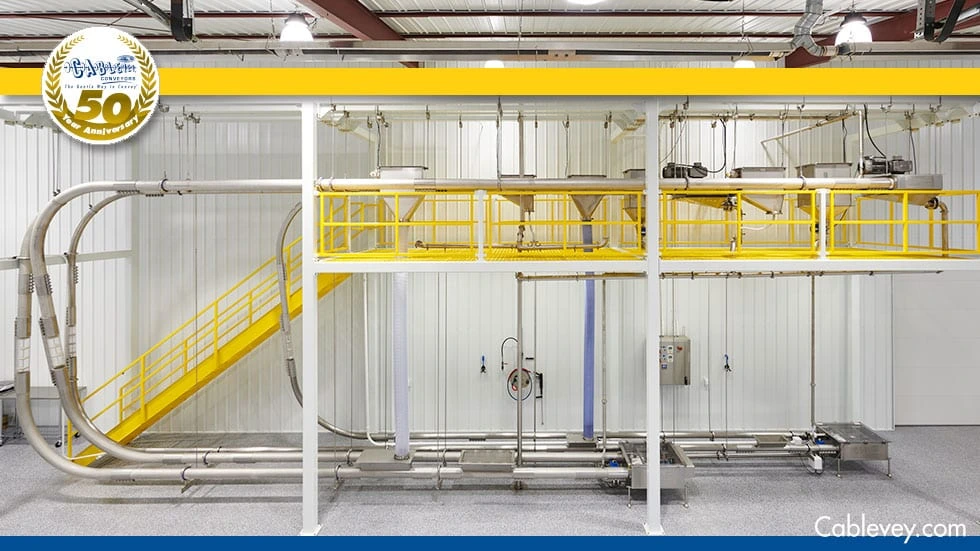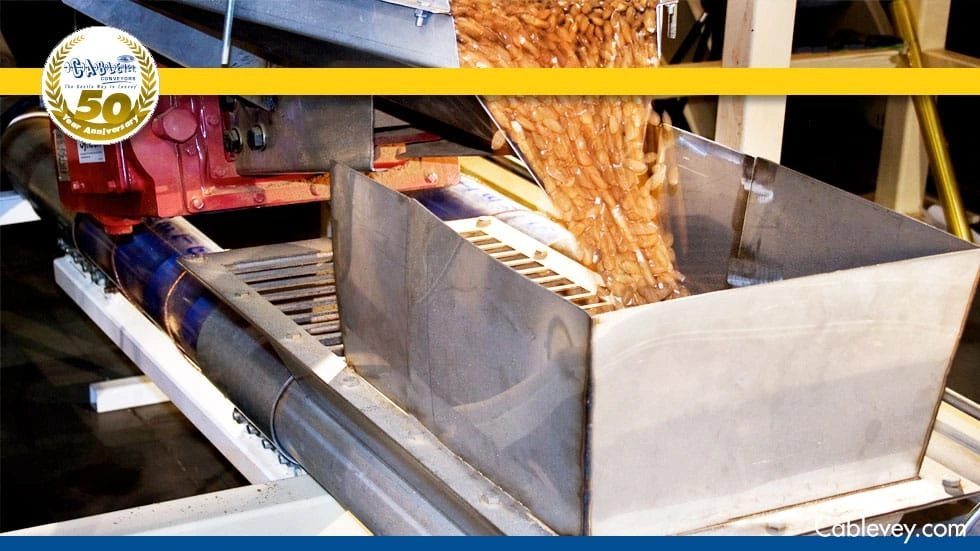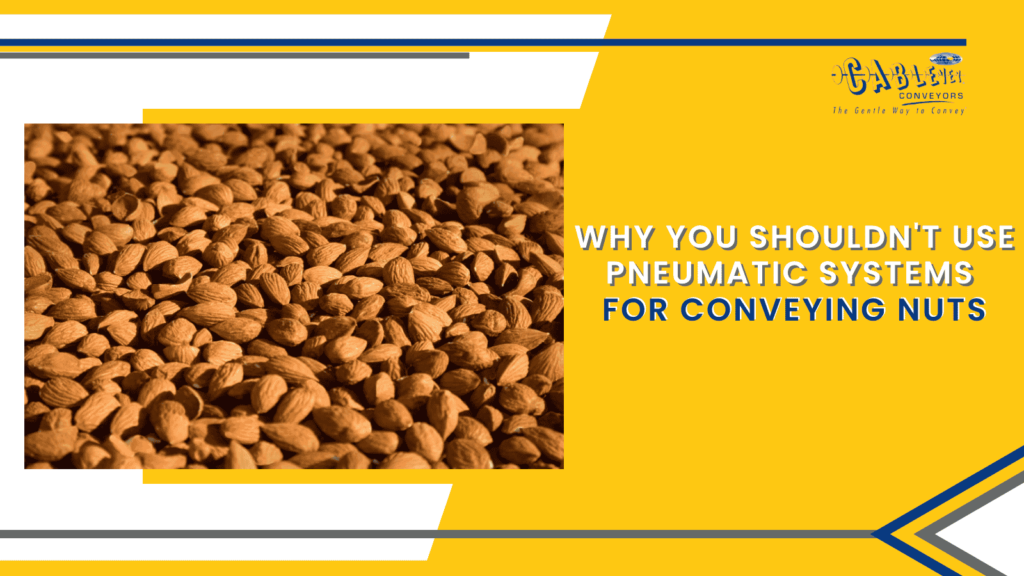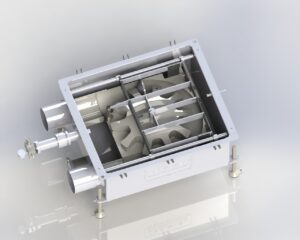When it comes to conveying nuts – almonds, cashews, walnuts, hazelnuts, and similar – one of the most commonly used types of conveyor is the pneumatic conveyor. However, it’s important to know that there are several reasons why you shouldn’t use pneumatic systems for conveying nuts. There are other more appropriate options when it comes to handling these delicate commodities. Let’s check them out.
Why You Shouldn’t Use Pneumatic Systems for Conveying Nuts?
Pneumatic systems, though efficient in many applications, pose significant drawbacks when it comes to conveying nuts. The inherent fragility of nuts makes them susceptible to damage and breakage at the high velocities characteristic of pneumatic conveyors. This risk of product loss and compromised quality, coupled with the energy-intensive nature of pneumatic systems, highlights the need for a more suitable solution.
How Do Pneumatic Conveyors Work?
Without a doubt, this conveyor engineering solution has many benefits and might be a good fit for facilities in a wide range of industries. Pneumatic conveyor solutions use air pressure that is either above or below the atmospheric level to move materials through a system.
They can be either vacuum conveyors or pressure conveyors, depending on the configuration that best suits the facility. The material to be conveyed is placed in a chamber where it is then blown or sucked through pipes to its destination via compressed air. Even a traditional belt conveyor system offers viable solutions for industries seeking reliable and damage-free material transport.

Explore the Advantages of This Automatic Conveyor System
There are different types of pneumatic conveyors, such as the dilute phase system and the dense phase system. The former is typically used for light materials (with low product density), while the latter is designed for heavier items (with higher bulk density). During dilute phase conveying, the product is moved at a velocity of over 59 ft/s, while in dense phase conveying, the velocities are lower (between 20 and 59 ft/s).
This high conveying speed is attractive to many facility managers since it’s much faster than other methods. Additional advantages of pneumatic conveyors include:
- Design flexibility – Pneumatic conveyors can be designed to transport materials horizontally, vertically, or at any angle in between.
- Relatively low maintenance – Since there are few moving parts, pneumatic conveyors don’t require much upkeep.
- Dust-free operation – Because they represent a closed system, these conveyors prevent dust from contaminating the product or escaping into the facility.
Reasons Why Pneumatic Systems Are Not Ideal for Conveying Nuts
As a material that needs to be transported, nuts are small, with a medium bulk density – characteristics that might suggest they are suitable for a dense phase pneumatic system. However, the reality is different. The inherent fragility of nuts makes them susceptible to damage, especially in high-velocity pneumatic systems. Let’s see other reasons why you should seek conveying alternatives.
Pneumatic Systems Are Not Gentle
One of the main reasons you shouldn’t use this type of automated conveyor system for moving nuts is that nuts are very fragile. They are hard and dry, prone to shattering and breaking. This is especially true for almonds, which have very delicate skin.
When using a pneumatic system, there is always the risk that the nuts might get damaged as they are being conveyed. The high velocities at which these industrial conveyor systems work can easily cause the nuts to break or even turn into powder. This is especially true if there are any sweeps or sharp turns in the conveyor layout.
There are reports that, in some cases, a whopping 10% of a fragile product was damaged by a high-velocity pneumatic system. And once the nuts are broken, there’s no going back – you can’t un-break an almond.
Damaged or broken nuts can, technically, be sorted out and reclaimed to make nut flour or butter. However, if the broken pieces make their way into the packaging process, they can end up ruining an entire batch of products. All of this is avoidable if you use a different type of conveyor that is better suited for conveying these fragile materials.
Pneumatic Systems Use a Lot of Energy
Technically, you could slow down a pneumatic conveyor enough to avoid major damage to your product. However, this would come at a cost – these automated conveyor systems are already energy-intensive, and slowing them down would make them even more so.
Large motors are required to generate the compressed air needed to power a pneumatic machine. Additionally, the compressors needed to maintain the pressure are also quite energy-demanding. As a result, pneumatic conveyors tend to have a very high energy consumption.
This is not ideal for facilities looking to reduce their carbon footprint or operating costs. If you want a more sustainable and cost-effective option, consider a less energy-intensive conveyor system.

What Is the Best Conveyor Alternative You Should Use Instead?
An ideal nut conveyor system would be one that has all the good features of a pneumatic conveyor without the negative ones. Fortunately, such a system exists – it’s called a tubular conveying system. Here are some of the most important advantages of this conveying system.
Tubular Drag Conveyors Are Gentle
One of the main advantages of these conveyor technologies is that they are very gentle on the product. This is thanks to the way they work – instead of using high-pressure air to move the product, they use circular discs evenly spaced out along a sealed cable inside a fully enclosed tube.
The spaces in between each of the discs create “pockets” in which the product is conveyed. The pockets move along the tube, propelling the product forward without causing any damage. The conveyed material virtually doesn’t move at all from the moment it enters the conveyor until it exits -there is no shaking, no jarring, and no impact.
This is perfect for conveying fragile materials like nuts, as there is no risk of them breaking or being damaged. Furthermore, you don’t have to worry about sacrificing your production time in order to prevent damage – these conveyors can work at speeds that are just the right balance of being gentle and efficient.
Tubular Drag Conveyors Are Energy-Efficient
Another advantage of tubular drag cable and disc conveyors is that they are very energy efficient. They require up to ten times less energy to operate than pneumatic systems. Although Cablevey Conveyors has some of the top-notch conveyor belt systems, the innovative tubular conveyor comes with drive units that require five horsepower to operate.
If you are looking to reduce your carbon footprint and save on energy costs, these conveyors are a great option. By reducing your energy bill, you are consequently increasing the long-term return on investment (ROI) of your tubular drag conveyor.
Other Benefits of Tubular Drag Conveyors
This is where alternatives like tubular drag conveyors, offered by Cablevey and other reputable belt conveyor manufacturers, come into play. Of course, that’s not all – tubular drag conveyors have many other advantages over pneumatic systems. Here are a few more reasons why you should consider them for your facility:
- They are incredibly easy to clean, especially with Cablevey’s clean-in-place systems and cleaning conveyor belts. Both wet and dry cleaning options are available, depending on your needs.
- They have a modular design, meaning they can be easily customized to fit your specific application. And, as your business grows, you can simply add more modules to increase your conveying capacity as your floor space increases.
- They are low maintenance and have a long lifespan. Tensioning the cable in our tubular cable and disc manufacturing conveyor systems is as easy as turning one knob on the control panel. Your facilities don’t have to experience extensive maintenance and repair downtime.
- They can transport your product horizontally, vertically, or around corners – all while being gentle on it. And because they are fully enclosed, they are ideal for conveying food products.
Overall, tubular drag conveyors are a better choice for conveying nuts over practically any other type of conveyor. They are gentle, energy efficient, easy to clean and maintain, and can be customized to your specific needs. If you’re looking for a top-quality nut conveyor, look no further – Cablevey has you covered.
Experience the Best Conveyor Manufacturing Process With Cablevey Conveyors
While pneumatic systems are common for nut conveying, they fall short in gentleness and energy efficiency. For delicate materials like nuts, a tubular drag conveyor, like those offered by Cablevey Conveyors, is the superior choice. Using circular discs ensures damage-free transport and boasts energy efficiency. Easy to clean, customizable, and with expert conveyor installation supervision, these conveyors provide an optimal solution. Cablevey Conveyors, one of the leading conveyor systems manufacturers, will elevate your nut-conveying process. Contact us today for effective and efficient solutions.






